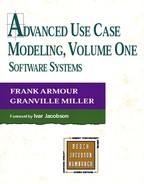Contents
Primary and Secondary Actor Types
Refactoring the Use Case Model
Extending the UML Use Case Process
Another Approach to Building a Use Case Model
Chapter 3. Scoping the System: Vision Document and Business Case
Describing the Problem: Vision Document
Determining Project Feasibility: Business Case
Chapter 4. Balancing the Software System Use Case Model
Defining a Software Architecture
Part 3. Advanced Use Case Modeling Framework: Initial Use Case Model
Chapter 5. Introduction to the System Use Case Modeling Process Framework
Need for a Software Development Process
Advanced Use Case Modeling Process Framework
Creating or Customizing a Process Framework for a Specific Project
Chapter 6. Preparing for Use Case Modeling and Determining Use Case Approach
Perform a Stakeholder Analysis
Select and Customize a Use Case Process Framework
Select Use Case Standards, Templates, and Tools
Determine Training and Mentoring Needs
Chapter 7. Performing Initial Use Case Modeling
Discover the Conceptual System Use Cases
Develop Initial Use Case Diagram
Determine/Refine the Conceptual Business Objects
Relationship of Use Cases and the Object Model
Packaging and Validating the Use Case Conceptual Model
Part 4. Advanced Use Case Modeling Framework: Expanding the Use Case Model
Chapter 8. Develop Base Use Case Descriptions
Fields in a Base Use Case Description
Getting Started Creating Base Use Case Descriptions
Chapter 9. Elaborate the Base Use Case Description
Text-Based Conditional and Iterative Logic in the Flow of Events
Using Activity Diagrams to Represent a Complex Flow of Events
Activity Diagrams versus Detailed Text
Chapter 10. Model Extend, Include, and Generalization Relationships
Bringing Together Extend, Include, and Generalization Relationships
Chapter 11. Add Supplemental Information to the Use Case Model
Focusing on Behavioral Details of Individual Use Case Activities
Documenting Details of Business Procedures and Rules
Chapter 12. Map Use Cases to Object Models
Parallel Use Case and Object Modeling
Mapping Use Cases to Object Models Using Sequence Diagrams
Issues with Using Sequence Diagrams during Analysis
Chapter 13. Develop Instance Scenarios
Use Case Instances Model Specific Executions of a Use Case
Use Cases Are to Object Classes as Use Case Instances Are to Object Instances
Why Create Use Case Instances?
Use Case Instances Can Be Applied Informally
Use Cases Can Be Applied More Formally
Layout of a Use Case Instance Description
Finding and Creating Use Case Instances
Chapter 14. Create Test Cases and Documentation
Chapter 15. Organize the Use Cases
Superordinate and Subordinate Use Cases
Activity Diagrams to Model Use Case Dependencies
Putting It All Together in a System Use Case Model
Chapter 16. Building User Interfaces
Conceptual User Interface Design
Creating Conceptual Models from Use Cases
Physical User Interface Design
Chapter 17. Coping with Change
Chapter 18. Creating Your Advanced Use Case Modeling Process
Effect of the Project and Project Team on Ceremony
Effects of Artifacts on Ceremony
Iterative Development and the Development Case
Chapter 19. Ensuring a Successful Use Case Modeling Effort
Appropriate Level of Detail and Organization in the Use Case Model
Attributes of a Good Use Case Model When Specifying Requirements
Incremental and Iterative Development with Use Cases
Know When Not to Use Use Cases
Questions to Ask When Use Case Modeling
Appendix A. Use Case Development Review Checklist
Appendix B. Development Case for Advanced Use Case Modeling
Appendix C. Simplified Loan Processing System
Appendix D. Simplified Loan Processing System User Interface Specification
